|
|
EGIPTOLOGIA: HATHOR, DIOSA DEL AMOR/ASTARTE/ASTORET/ISTAR
Triar un altre plafó de missatges |
|
|
Hathor
De Wikipedia, la enciclopedia libre
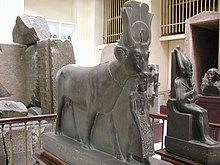
Escultura de Hathor como vaca con los símbolos del disco solar, uraeus, collar y corona.
Hathor fue una divinidad cósmica, diosa nutricia, diosa del amor, de la alegría, la danza y las artes musicales en la mitología egipcia. Su nombre significa "El templo de Horus" o "La morada de Horus", para identificarla como madre del mismo y, a veces, su esposa.
- Nombre egipcio Hut-Hor (Ḥwt Ḥr). Nombre griego: Hathor. Deidad griega: Afrodita. Deidad fenicia: Astarté. Deidad semita: Astoret.
[editar] Iconografía
Hathor es comúnmente representada como una diosa vaca con cuernos que sujetan un disco solar con uraeus. En otras representaciones es simplemente una mujer con orejas de vaca o una vaca (a veces con manchas en su pelaje). En períodos posteriores, a veces porta plumas gemelas y un collar menat.
Hathor en su representación más primitiva podría ser la diosa vaca de la Paleta de Narmer y de una urna de piedra que datan de la dinastía I, que sugieren un papel de diosa celeste y su relación con Horus, quien, como dios sol, es "alojado" en ella.
Su atributo era el sistro, un tallo de papiro y es de las pocas diosas que puede portar el cetro uas.
[editar] Mitología e Historia
Considerada hija de Ra, ojo de Ra y esposa del dios Horus, aunque en algunas representaciones ceremoniales aparezca como madre del dios asociada a Isis. Según la mitología egipcia juntos vengaron la muerte del padre de Horus, el dios Osiris.
Alimenta y da vida del árbol celestial. Con la imagen de vaca, acoge y protege a los difuntos, ofreciendo alimentos a los muertos y ayudándolos para no sufrir.
[editar] Sincretismo
Su veneración proviene ya de la época predinástica, donde pudo ser un desarrollo de los primitivos cultos a la fertilidad y a la naturaleza en general, representados por una vaca o una diosa celeste (no confundir con Nut) con aspecto de vaca con piel manchada de estrellas. Muy pronto se la asimiló con la antigua diosa Bat y más tarde se la conocería como Bat-Hathor.
Tardíamente se le identificó con Isis, quien la reemplazó como madre de Horus.
Se han podido identificar alrededor de doscientos epítetos de Hathor a lo largo de la historia. Un himno a Hathor dice:
- Eres la Señora de la alegría, la Reina de la danza, la Maestra de la música, la Reina de la tañedora del arpa, la Dama de la danza coral, la Reina de la tejedora de guirnaldas, la señora de la borrachera sin fin.
- "La Señora del occidente", "La Señora benefactora de los difuntos" o "Diosa de la montaña occidental" como señora de los muertos y alimentadora de los difuntos en su viaje al Más Allá.
- "La Señora de la llama de oro", como fuego que consume el amor y diosa de la alegría y los placeres.
- "La Dorada que está en los estanques rebosantes de aves, en los lugares placenteros", como símbolo de la alegría de vivir.
- "La Señora del sicomoro", que habita en los árboles, identificando la dura madera del sicomoro, árbol endémico de Egipto, con la confección de sarcófagos y sus higos con la nutrición, siendo representada a veces con un sicomoro amamantando al rey, transmitiéndole la divinidad.
- "La Vaca que asoma entre los papiros", como parte de los rituales al recolectar papiros.
- "La Señora del Punt", por la expedición que se realizó en época de Hatshepsut al país del Punt.
- "La Señora de la turquesa", como venerada por los trabajadores de las minas de turquesa en Serabit el-Jadim en el suroeste de la península del Sinaí.
- "La Señora de Biblos", donde probablemente absorbería una divinidad local de Biblos.
- "La Señora de los rizos", por sus sacerdotisas, que llevaban pelucas de este tipo.
Su principal centro de culto estuvo en Iunu y en época más tardía pasó al importante Templo de Hathor en Dendera como diosa del amor, la maternidad, la belleza juvenil, la alegría y el erotismo. Fue diosa del nomo XXII del Alto Egipto, III del Bajo Egipto y de varios del Egipto Medio.
El matrimonio Horus-Hathor era venerado en el Alto Egipto, sobre todo en la zona de Tebas donde tenían lugar las fiestas anuales en honor a ambas deidades.
Además de los anteriores, tuvo templos dedicados en Abu Simbel –identificada con Nefertari–, File, Deir el-Medina, Deir el-Bahari, Serabit el-Jadim (Sinaí), Gebelein y otras ciudades denominadas Afroditópolis.
[editar] Capitel hathórico
La imagen de la cabeza de la diosa fue esculpida en los capiteles de las columnas de varios templos y capillas erigidos en su honor: son los denominados capiteles hathóricos. Era la única diosa egipcia representada de tan singular manera.
[editar] Hathor en la península del Sinaí
Según las inscripciones, los trabajadores de las minas del Sinaí veneraban a Hathor. El templo principal de Hathor fue construido por Sethy II hacia 1200 a. C. junto a las minas de cobre de Timna, en el Seir edomita. Serabit el-Jadim (en árabe: سرابت الخادم) es una localidad en el suroeste de la península del Sinaí donde fueron extraídas turquesas desde la antigüedad, principalmente para los egipcios. Excavaciones arqueológicas iniciadas por Flinders Petrie revelaron explotaciones mineras y un templo de Hathor.
Hay teorías que indican que el becerro de oro mencionado en la Biblia pudiera ser una imagen artística del culto a Hathor (Exodo 32:4-6) en estos lugares.
http://es.wikipedia.org/wiki/Hathor
|
|
|
|
|
| lionsgate in Simple Gematria Equals: 102 |
( |
l
12 |
i
9 |
o
15 |
n
14 |
s
19 |
g
7 |
a
1 |
t
20 |
e
5 |
) |
| lions in Simple Gematria Equals: 69 |
( |
l
12 |
i
9 |
o
15 |
n
14 |
s
19 |
) |
| gate in Simple Gematria Equals: 33 |
( |
g
7 |
a
1 |
t
20 |
e
5 |
) |

EL SOL, SI USTED MIRA HACIA EL NORTE Y EN EL CONTEXTO A QUE EL MISMO SALE POR EL ESTE Y SE PONE EN EL OESTE, SE MUEVE EN SENTIDO HORARIO, osea el mismo numero 6 y LA LUNA, en su movimiento de 29.53059 dias SALE EN EL OESTE Y SE PONE EN EL OESTE, osea que se mueve en sentido antihorario. SOL-O-MON / DOS LUMBRERAS / CUARTO DIA DE LA CREACION / MIERCOLES / MERCURIO / GOD /DOG / CONVERSION DEL MERCURIO EN ORO / ALQUIMIA /SANTO GRIAL. EL FLUJO MAGNETICO DE UNA BOBINA simula incluso al flujo del agua de un rio que simboliza al FLUJO DEL AGUA VIVA, simbolo del ESPIRITU SANTO/PENTECOSTES/SHAVUOT. El mismo flujo simboliza a la UNION ENTRE EL HOMBRE Y LA MUJER, ya que observamos se dan los dos tipos de flujos ya sean en sentido horario o antihorario.
En Hechos 12:12 (1+2,1+2:3,3 o 33) es PEDRO el que aparece con Maria la madre de Juan Marcos.
Hechos 12:12: Y habiendo considerado esto, llegó a casa de María la madre de Juan, el que tenía por sobrenombre MARCOS, donde muchos estaban reunidos orando.
La mujer le dijo: Señor, no tienes con qué sacarla, y el pozo es hondo. ¿De dónde, pues, tienes el AGUA VIVA?
4. Juan 7:38: El que cree en mí, como dice la Escritura, de su interior correrán ríos de AGUA VIVA
EL AGUA VIVA, ES UNA REFERENCIA ESPIRITUAL AL FLUJO DEL ESPIRITU SANTO. OBSERVEN QUE EL CANGREJO TIENE FORMA DE FLUJO, ADONDE OBSERVAMOS QUE EN LA PARTE SUPERIOR TIENE UN SENTIDO Y EN LA PARTE INFERIOR TIENE OTRO. SABEMOS QUE UN RIO DE AGUA VIVA TIENE AMBOS FLUJOS. ES POR ESO QUE NUESTRO SEÑOR JESUCRISTO HIZO REFERENCIA AL AGUA VIVA A LA SAMARITANA. EL MENSAJE DE NUESTRO SEÑOR ESOTERICO DE NUESTRO SEÑOR ES OBVIO. YO TAMBIEN TENGO UNA ESPOSA Y ESO EXPLICA DEL PORQUE LA INTERRELACION DEL ESPIRITU SANTO CON EL AGUA VIVA. SABEMOS QUE LAS PRESAS O DIQUES SON GENERADORES DE ELECTRICIDAD.
En los rios, al igual que en los campos magneticos tambien tenemos el flujo horario que simboliza al hombre y el flujo antihorario que simboliza la mujer.
Juan 20
1. El primer día de la semana, María Magdalena fue de mañana, siendo aún oscuro, al sepulcro; y vio quitada la piedra del sepulcro. (AUN NO HABIA SALIDO EL SOL)
2. Entonces corrió, y fue a Simón Pedro y al otro discípulo, aquel al que amaba Jesús, y les dijo: Se han llevado del sepulcro al Señor, y no sabemos dónde le han puesto. (El discipulo amado es JUAN MARCOS, el hijo de Nuestro Señor y Nuestra Señora madre)
3. Y salieron Pedro y el otro discípulo, y fueron al sepulcro.
4. Corrían los dos juntos; pero el otro discípulo corrió más aprisa que Pedro, y llegó primero al sepulcro.
5. Y bajándose a mirar, vio los lienzos puestos allí, pero no entró.
6. Luego llegó Simón Pedro tras él, y entró en el sepulcro, y vio los lienzos puestos allí,
7. y el sudario, que había estado sobre la cabeza de Jesús, no puesto con los lienzos, sino enrollado en un lugar aparte.
8. Entonces entró también el otro discípulo, que había venido primero al sepulcro; y vio, y creyó.
9. Porque aún no habían entendido la Escritura, que era necesario que él resucitase de los muertos.
10. Y volvieron los discípulos a los suyos.
11. Pero María estaba fuera llorando junto al sepulcro; y mientras lloraba, se inclinó para mirar dentro del sepulcro;
12. y vio a dos ángeles con vestiduras blancas, que estaban sentados el uno a la cabecera, y el otro a los pies, donde el cuerpo de Jesús había sido puesto.
13. Y le dijeron: Mujer, ¿por qué lloras? Les dijo: Porque se han llevado a mi Señor, y no sé dónde le han puesto.
14. Cuando había dicho esto, se volvió, y vio a Jesús que estaba allí; mas no sabía que era Jesús.
15. Jesús le dijo: Mujer, ¿por qué lloras? ¿A quién buscas? Ella, pensando que era el hortelano, le dijo: Señor, si tú lo has llevado, dime dónde lo has puesto, y yo lo llevaré.
16. Jesús le dijo: ¡María! Volviéndose ella, le dijo: ¡Raboni! (que quiere decir, Maestro).
17. Jesús le dijo: No me toques, porque aún no he subido a mi Padre; mas ve a mis hermanos, y diles: Subo a mi Padre y a vuestro Padre, a mi Dios y a vuestro Dios.
18. Fue entonces María Magdalena para dar a los discípulos las nuevas de que había visto al Señor, y que él le había dicho estas cosas. (Observen que MARIA MAGDALENA CONCLUYE LA REDENCION DE NUESTRO SEÑOR. MARIA MAGDALENA TAMBIEN ES COREDENTORA)
19. Cuando llegó la noche de aquel mismo día, el primero de la semana, estando las puertas cerradas en el lugar donde los discípulos estaban reunidos por miedo de los judíos, vino Jesús, y puesto en medio, les dijo: Paz a vosotros. (Para JUAN o el escritor del CUARTO EVANGELIO CRISTO JESUS RESUCITO EN PENTECOSTES. INCREIBLEMENTE LA FIESTA DE ISTAR ERA EN EL VERANO. OSEA QUE MARIA LA MAGDALENA ES LA NUEVA ISTAR/ISHTAR. Noten la interrelacion con las "PUERTA CERRADAS" es una obvia referencia a la PUERTA DE ISTAR. EL MENSAJE ESTA CLARO. ¿PORQUE CRISTO SE LE APARECIO A MARIA LA MAGDALENA EN PENTECOSTES O SINO PORQUE AQUI JUAN HACE REFERENCIA A PENTECOSTES?)
20. Y cuando les hubo dicho esto, les mostró las manos y el costado. Y los discípulos se regocijaron viendo al Señor.
21. Entonces Jesús les dijo otra vez: Paz a vosotros. Como me envió el Padre, así también yo os envío.
22. Y habiendo dicho esto, sopló, y les dijo: Recibid el Espíritu Santo. (Aqui se confirma que la referencia es a PENTECOSTES. Esto es una referencia a CANCER/AGUA VIVA/SOL Y LUNA/SOL-O-MON / MERCURIO / MIERCOLES /CUARTO DIA DE LA CREACION /ALQUIMIA / GRIAL. EL 5 justamente tiene referencia a la CUADRATURA DEL CIRCULO. EL CUADRADO EN SU PARTE SUPERIOR Y EL CIRCULO EN LA INFERIOR. Aunque CRISTO NO HAYA RESUCITADO EN PENTECOSTES, pero esta claro que LA INTERRELACION ESTA.)
23. A quienes remitiereis los pecados, les son remitidos; y a quienes se los retuviereis, les son retenidos.
MATEO 24
26. Así que, si os dijeren: Mirad, está en el desierto, no salgáis; o mirad, está en los aposentos, no lo creáis.
27. Porque como el relámpago que sale del oriente y se muestra hasta el occidente, así será también la venida del Hijo del Hombre.
28. Porque dondequiera que estuviere el cuerpo muerto, allí se juntarán las águilas.
29. E inmediatamente después de la tribulación de aquellos días, el sol se oscurecerá, y la luna no dará su resplandor, y las estrellas caerán del cielo, y las potencias de los cielos serán conmovidas. (Una referencia al CUARTO DIA DE LA CREACION en que fueron creadas las dos lumbreras y las estrellas. Nosotros sabemos que en la semana actual el MIERCOLES/MERCURIO es el cuarto dia. UNA REFERENCIA A LA ALQUIMIA, OSEA EL GRIAL)
30. Entonces aparecerá la señal del Hijo del Hombre en el cielo; y entonces lamentarán todas las tribus de la tierra, y verán al Hijo del Hombre viniendo sobre las nubes del cielo, con poder y gran gloria.
31. Y enviará sus ángeles con gran voz de trompeta, y juntarán a sus escogidos, de los cuatro vientos, desde un extremo del cielo hasta el otro.
32. De la higuera aprended la parábola: Cuando ya su rama está tierna, y brotan las hojas, sabéis que el verano está cerca. (El verano es PENTECOSTES)
33. Así también vosotros, cuando veáis todas estas cosas, conoced que está cerca, a las
puertas. (Observen la referencia a las PUERTAS. YHWH MANEJA TODO. ESTA TODO CODIFICADO PARA MALDICION DE LOS EGOLATRAS.)
STAR GATE
Juan 4
1. Cuando, pues, el Señor entendió que los fariseos habían oído decir: Jesús hace y bautiza más discípulos que Juan
2. (aunque Jesús no bautizaba, sino sus discípulos),
3. salió de Judea, y se fue otra vez a Galilea.
4. Y le era necesario pasar por Samaria.
5. Vino, pues, a una ciudad de Samaria llamada Sicar, junto a la heredad que Jacob dio a su hijo José. (JOSE, EL HIJO DEL SOL/JACOB Y LA LUNA/RAQUEL, SEGUN EL SUEÑO DE JOSE DE GENESIS 37, JOSE ES LA ESTRELLA. AQUI HAY UNA REFERENCIA A LA FIESTA DE ISHTAR/SHAVUOT/STAR/ESTRELLA. SOL-O-MON, SOL Y LUNA, CUARTO DIA DE LA CREACION, MIERCOLES, MERCURIO, ALQUIMIA, ETC,ETC)
6. Y estaba allí el pozo de Jacob. Entonces Jesús, cansado del camino, se sentó así junto al pozo. Era como la hora sexta.
7. Vino una mujer de Samaria a sacar agua; y Jesús le dijo: Dame de beber.
8. Pues sus discípulos habían ido a la ciudad a comprar de comer.
9. La mujer samaritana le dijo: ¿Cómo tú, siendo judío, me pides a mí de beber, que soy mujer samaritana? Porque judíos y samaritanos no se tratan entre sí. (JESUS ERA JUDIO PARA BRONCA DE LOS NAZIS)
10. Respondió Jesús y le dijo: Si conocieras el don de Dios, y quién es el que te dice: Dame de beber; tú le pedirías, y él te daría agua viva. (CRISTO JESUS COMPARA AL ESPIRITU SANTO CON EL AGUA VIVA O AGUA EN MOVIMIENTO, OSEA UN RIO)
11. La mujer le dijo: Señor, no tienes con qué sacarla, y el pozo es hondo. ¿De dónde, pues, tienes el agua viva?
12. ¿Acaso eres tú mayor que nuestro padre Jacob, que nos dio este pozo, del cual bebieron él, sus hijos y sus ganados?
13. Respondió Jesús y le dijo:Cualquiera que bebiere de esta agua, volverá a tener sed;
14. mas el que bebiere del agua que yo le daré, no tendrá sed jamás; sino que el agua que yo le daré será en él una fuente de agua que salte para vida eterna.
15. La mujer le dijo: Señor, dame esa agua, para que no tenga yo sed, ni venga aquí a sacarla.
16. Jesús le dijo: Ve, llama a tu marido, y ven acá.
17. Respondió la mujer y dijo: No tengo marido. Jesús le dijo: Bien has dicho: No tengo marido;
18. porque cinco maridos has tenido, y el que ahora tienes no es tu marido; esto has dicho con verdad.
19. Le dijo la mujer: Señor, me parece que tú eres profeta.
20. Nuestros padres adoraron en este monte, y vosotros decís que en Jerusalén es el lugar donde se debe adorar.
21. Jesús le dijo: Mujer, créeme, que la hora viene cuando ni en este monte ni en Jerusalén adoraréis al Padre. (CRISTO JESUS, COMO BUEN JUDIO, ERA UNITARIO, NO TRINITARIO)
22. Vosotros adoráis lo que no sabéis; nosotros adoramos lo que sabemos; porque la salvación viene de los judíos.
23. Mas la hora viene, y ahora es, cuando los verdaderos adoradores adorarán al Padre en espíritu y en verdad; porque también el Padre tales adoradores busca que le adoren.
24. Dios es Espíritu; y los que le adoran, en espíritu y en verdad es necesario que adoren.
25. Le dijo la mujer: Sé que ha de venir el Mesías, llamado el Cristo; cuando él venga nos declarará todas las cosas.
26. Jesús le dijo: Yo soy, el que habla contigo.
27. En esto vinieron sus discípulos, y se maravillaron de que hablaba con una mujer; sin embargo, ninguno dijo: ¿Qué preguntas? o, ¿Qué hablas con ella?
28. Entonces la mujer dejó su cántaro, y fue a la ciudad, y dijo a los hombres:
29. Venid, ved a un hombre que me ha dicho todo cuanto he hecho. ¿No será éste el Cristo?
30. Entonces salieron de la ciudad, y vinieron a él.
31. Entre tanto, los discípulos le rogaban, diciendo: Rabí, come.
32. El les dijo: Yo tengo una comida que comer, que vosotros no sabéis.
33. Entonces los discípulos decían unos a otros: ¿Le habrá traído alguien de comer?
34. Jesús les dijo: Mi comida es que haga la voluntad del que me envió, y que acabe su obra.
35. ¿No decís vosotros: Aún faltan cuatro meses para que llegue la siega? He aquí os digo: Alzad vuestros ojos y mirad los campos, porque ya están blancos para la siega. (Aqui se confirma que el VERDADERO SHAVUOT/PENTECOSTES es en el quinto mes hebreo 29 de thamus/primero de Av EN LUNA LLENA EN SOLSTICIO)
 |
| Río Magdalena a la altura de Mompox, Bolívar |
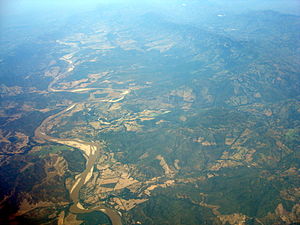 |
| El Magdalena a su paso entre Cundinamarca y Tolima. |
MARCA/MARCOS
|
|
|
|
|
|
Great Celestial Conjunction Crosses
Part II: Crosses in the Old World
Jan Wicherink
|
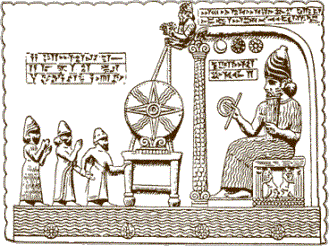
Utu/Shamash the ancient Sun God of Mesopotamia
Download this article in PDF form here
|
|
|
Introduction
This article is the sequel to the Great Celestial Conjunction crosses that appear in the New World. In part I the Great Celestial Conjunction was discussed that is occurring in era-2012 when the Earth Cross aligns with the Galactic Cross. It was demonstrated how this knowledge was encrypted in the creation myths and artefacts of the Mesoamerican natives, the Maya and the Aztecs.
In this article it will be shown that the same knowledge also existed in the Old World. This article is meant to demonstrate the principles only and in no way does it claim to be a complete survey of the ancient understanding of precession and Great Celestial Conjunctions. It should be regarded as an eye-opener to the possibility that the ancients understood that there are two crosses involved in the precession cycle that define the moments of the Great Celestial Conjunctions.
These crosses are encoded in artefacts by means of the 4 and 8 pointed crosses that represent the Earth Cross (cross of the Zodiac) and the Galactic Cross (intersection of the Galactic Equator with the ecliptic and its perpendicular axis). When the rotating Earth Cross is superimposed over the fixated Galactic Cross an 8 pointed cross is formed. The two crosses become conjunct at four moments during a precession cycle when they overlap to form one four pointed cross. This event is called a Great Celestial Conjunction and is happening in between the years 1978-2017.
In this part the symbolism of the 4 pointed cross and the 8 pointed crosses in the Old World will be discussed and we will demonstrate how the Great Celestial Conjunctions was understood and encoded in the myths and mysteries of the ancient past.
The premise of this article is that in ancient times in the Old World the Galactic Cross was denominated by the signs Taurus, Aquarius, Scorpio and Leo.
These signs are mentioned in the book of Revelations and Ezekiel as the four Cherubim that would return at the ‘End of Times’ and I therefore suggest that it represents the intersection of the Milky Way and the ecliptic and its perpendicular axis. Scorpio as one of the four Cherubim is often replaced by the Eagle representing the constellation Ophiuschus near Scorpio.
Ezekiel 1:10 : As for the likeness of their faces, they four had the face of a man, and the face of a lion, on the right side: and they four had the face of an ox on the left side; they four also had the face of an eagle.
Revelations 4:6-8:
6. And before the throne there was a sea of glass like unto crystal: and in the midst of the throne, and round about the throne, were four beasts full of eyes before and behind.
7. And the first beast was like a lion, and the second beast like a calf, and the third beast had a face as a man, and the fourth beast was like a flying eagle.
8. And the four beasts had each of them six wings about him; and they were full of eyes within: and they rest not day and night, saying, Holy, holy, holy, LORD God Almighty, which was, and is, and is to come.
While the Galactic Equator intersects the ecliptic in 5° Sagittarius and 5° Gemini in the sidereal zodiac, the boundaries of the signs Taurus, Aquarius, Scorpio and Leo are within a 5° range of the true Galactic Cross in the sidereal zodiac.
The reason why the signs Taurus, Aquarius, Scorpio and Leo were used to denote the Galactic Cross might be explained by the fact that the ancients, the Sumerians, Babylonians and Egyptians were more interested in the heliacal rising of constellations. The Egyptians for instance based their calendar on the heliacal rising of Sirius. The heliacal rising and setting of stars were incorporated into both calendars and zodiacs. The signs Taurus, Aquarius, Scorpio and Leo are the constellations that heliacally rise before the constellation that define the true Galactic Cross 5° Gemini, 5° Pisces, 5° Sagittarius and 5° Virgo in the sidereal zodiac.
Babylon, origin of the 8 pointed cross
In ancient Babylon the Akkadian god Shamash (Sumerian Sun god Utu) was depicted as an 8 pointed star or 8 pointed cross. His name means Sun and temples were dedicated to Utu/Shamash in Babylon, Ur, Mari, Nippur and Nineveh. Shamash is the keeper of the Shenu (O| ring), a symbol that was also known in Egypt as the Shen. The symbol contains a coiled rope and it represents the orbit of the Sun or the ecliptic. It is also a symbol of undefined time and eternity and might therefore also represent the Sun’s orbit along the ecliptic in the precessional cycle. In the picture below Shamash is seated on a throne that is floating on water holding the Shenu. The water symbolically represents the river in the sky, the Milky Way. The 8 pointed solar disk is brought before Shamash on the offer table. Notice that this 8 pointed cross consists of two different four pointed crosses that are superimposed! Also notice that below the Sun disk cross two snake-like curls appear, they represent the ecliptic. The resemblance of the Mesopotamian Sun disk with the Aztec Sunstone is striking! Both have two four pointed crosses with the ecliptic snake like curls at the bottom of the Sun disk.
The pillar in front of Shamash is adorned with the same snake like curls at the base and capital of the pillar resembling the classical Greek Ionic style. As we will abundantly demonstrate in this article, the pillar in ancient times was associated with the Milky Way. Vincent Bridged and John Major Jenkins convincingly argued that the Egyptian Djed pillar must be associated with the Milky Way too. Notice that the pillar contains the curls at both the bottom and the top of the pillar! If capital and base curls represent the ecliptic, the two curls on both ends of the pillar represent the two crossing points of the ecliptic and the Milky Way that occur at a 180 degrees angle apart (The Gemini-Taurus nexus and the Sagittarius-Scorpio nexus). Shamash is seated on a throne that is supported by two pillars and the pillars are supported by two figures (unidentified). Shamash (the Sun) is seated on top of the pillars (Milky Way) representing the two crossings of the ecliptic and Milky Way where the Sun is ‘seated’ on the Milky Way.
Top: Seal of the Sun god Utu/Shamash (Two separate four pointed crosses)
Bottom: Aztec Sun Stone with the 8 pointed cross and the snake curls
(See part I of this article).
Above Shamash three circles appear, the two on the right are the 8 pointed crosses; the one on the left is an eclipse symbol representing a conjunction!
At the bottom on the river four 8 pointed crosses are depicted. I suggest that they represent the four Great Celestial Conjunctions that appear in a Great Year.
The Sumerian epic of Gilgamesh is believed to be an allegory of the precessing of the Sun along the zodiac signs in the precession cycle. The epic recounts Gilgamesh slaying of the Heavenly Bull (Taurus). The killing of the bull enraged Ishtar who had complained to the god Anu and asked for the Bull of the Heaven when Gilgamesh refused to marry her. After Gilgamesh and his friend Enkidu killed the bull they offered its heart to Utu/Shamash (the Sun).
This epic is believed to recount the transition of equinox sun from the Age of Taurus into the Age of Aries. Gilgamesh after his victory over the Bull of the Heavens became the first Sumerian shepherd King (Aries is the sign of the sheep). Ishtar in the epic is associated with the vernal equinox that determines the current Age in the precession cycle. This is why we still celebrate Easter (Ishtar) around the vernal equinox.
In the epic of Gilgamesh we also find a recount of the Great Flood. A retelling of the Sumerian version of the Deluge is found in the Old Testament and is known as the biblical story of Noah’s Ark. The epic of Gilgamesh is recorded in twelve clay tablets (signs of the zodiac) within a cyclic nature that is to say that the beginning lines are quoted in the 11th tablet. In the 12th tablet Gilgamesh enters into the Underworld. In another epic Ishtar enters the underworld through the seven gates offering one piece of clothing for each gate that she passes. By the time she has entered into the underworld she stands naked. This tale may relate to the spiritual evolution of mankind and the spiritual development through the seven planes of consciousness corresponding with the 7 chakras to finally meet the naked Higher Self at the end of his spiritual journey.
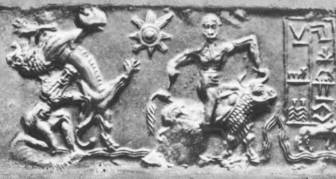
Gilgamesh and Enkidu fighting a lion (Leo) and a bull (Taurus).
Notice the 8 rays of the Sun Utu/Shamash!
Cylinder seal from Ur.
Did the Sumerians understand that there is a fixed cross in the sky?
The Ishtar Gate was the 8th gate to Babylon and its walls contained bulls and dragons (serpents) that were depicted interchangeably. Through the gate ran the Processional Way into the city to the temple of Marduk. At a right angle to the walls of the gate we find a wall adorned with lions! The Ishtar Gate is symbolizing two of the four Cherubim signs of the zodiac at right angles exactly as they appear on the zodiac and may therefore represent the fixed cross or the Galactic Cross.
Left and centre: Gate of Ishtar entrance to Babylon, bull and lion.
Right: reconstruction of the Gate of Ishtar at the Museum of Berlin, the bull occurs on
the gate wall while the lion occurs on the wall of the Procession Way.
The Babylonian deity Ea or Sumerian deity Enki was the precursor of the biblical serpent in the Garden of Eden. He was the creator of man and therefore also the precursor of the biblical Yahweh-Elohim. He denied man immortality, changed man’s single language into plural languages such that they could no longer understand each other and like Gilgamesh and Noah warned man to build an Ark for the coming Great Flood. The Great Flood occurred around a Great Celestial Conjunction estimated around 10.500 BC.
Left: Ea/Enki on his throne with the four pointed cross.
Right: Ea/Enki and his pointing pole (staff) Nirah the serpent
In the picture on the right Ea/Enki is holding a scorpion in his hands while he’s wearing he bull horns very similar to the horns of the Egyptian Isis-Hathor deity who was wearing the bull horns with a solar disk in between her horns!
Scorpio and Taurus are two of the four signs of the Galactic Cross and correspond with the Galactic Equator. The Ea/Enki serpents represent the ecliptic and the picture therefore suggests the crossings of the ecliptic with the Galactic Equator.
Notice in the pictures on the left that Ea/Enki is seated on a throne with a single four pointed cross on it (the cross of a Great Celestial Conjunction). Water is pouring from his shoulders symbolizing the Milky Way. Ea/Enki as the serpent (ecliptic) intersects with the waters pouring from his shoulders (the Milky Way) and therefore also represents the crossing of the ecliptic and the Milky Way.
The two guards next to Ea/Enki guard the gate of the Gods to the underworld that has been associated with the Galactic Equator-ecliptic crossings at the Sagittarius-Scorpio and Gemini-Taurus nexus.
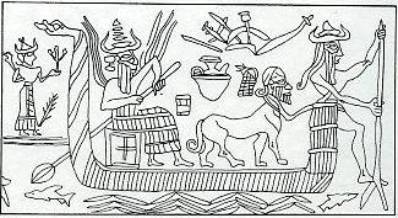
Utu/Shamash in his serpent boat on the waters
In the picture above we see Utu/Shamash with the fiery solar rays emanating from his shoulders in his serpent boat (Ecliptic) on the waters (Milky Way). Ashore Ishtar (Vernal Equinox) is watching. Notice that the Sun God is seated on his throne with a single four pointed cross? We also see a lion (Leo) on board the boat of Utu/Shamash. This picture I think represents the Great Celestial Conjunction that occurred around the Great Flood 10.500 BC when the vernal equinox (Ishtar) was in Leo. Shamash as the 8 pointed cross has transformed into the single four pointed cross of his throne!
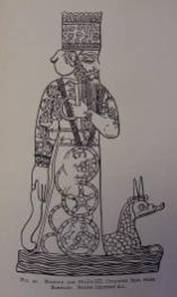
Sumerian Marduk, 9th century BC cylinder seal found at Babylon
In the picture above we see the Sumerian God Marduk on the waters (Milky Way). Next to him a serpent (Ecliptic) with two horns (Taurus) in depicted. Notice that Marduk is wearing the 8 pointed cross (Shamash/Uto) necklace (it’s damaged in the seal). In his hands he’s holding the Shenu (O-ring) a symbol very similar to the Egyptian Shen and Ankh and I suggest that it represents the Sun on the Galactic Equator. The Egyptian Ankh was later given an additional cross sign below the Sun +O such that it would represent the Sun on the crossing of the ecliptic and Milky Way (more on that later). This seal could be interpreted to represent again the Great Celestial Conjunction around 10.500 BC this time however it is presented as the summer solstice Sun on the ecliptic-Milky Way crossing at the Gemini-Taurus nexus.
Left: Utu/Shamash rising from Mt.Mashu (Zechariah Sitchen)
Right: 8 pointed cross (Shamash) and two different four pointed crosses that when
superimposed form an 8 pointed cross!
According to Zecharia Sitchen in the picture above we see Utu/Shamash rising from Mount Mashu to bring the Golden Age! Notice the 8 pointed cross left of Utu/Shamash that symbolizes the Sun God. Below the 8 pointed cross we see two different four pointed crosses (+ and x) that when superimposed from the 8 pointed cross! On the right we see another 8 pointed cross. The Sumerian God is standing in between two hills of Mount Mashu flanked by banners. The two hills resemble the pylons of the Egyptian solar temples as well as the Egyptian Akhet (horizon) between which the sun rose.
Daniel 7: 1-4
1 In the first year of Belshazzar king of Babylon Daniel had a dream and visions of his head upon his bed: then he wrote the dream, and told the sum of the matters.
2 Daniel spake and said, I saw in my vision by night, and, behold, the four winds of the heaven strove upon the great sea.
3 And four great beasts came up from the sea, diverse one from another.
4 The first was like a lion, and had eagle's wings: I beheld till the wings thereof were plucked, and it was lifted up from the earth, and made stand upon the feet as a man, and a man's heart was given to it
It is my premise that the cross of the Cherubim signs corresponds with one of the four pointed crosses that compose the 8 pointed cross of Utu/Shamash!
|
|
|
|
|
|
|
Egypt
The four cherubim can also be found in Egypt where they are represented by sphinxes. Sphinxes were placed near the entrance of temples and they were often placed on pillars. Sphinxes incorporated all of the four Cherubim signs of the zodiac, since it had the face of a man (Aquarius), the legs of a bull (Taurus) and the body of lion (Leo) along with the wings of the Eagle (Scorpio) mentioned in Revelations 4:8.
Sphinx on a pillar
The famous Sphinx at Giza is facing due East where it aligned with its celestial counter part Leo at the vernal equinox around 10.500 BC (Time of the Great Flood). This was the time that the summer solstice Sun aligned with the Dark Rift of the Milky Way; it was the time of a Great Celestial Conjunction.
When the sphinx is placed on top of a pillar its significance becomes apparent since the pillar represents the Milky Way and the four Cherubim represent the Galactic Cross. The most important pillar in ancient Egypt was the Djed pillar and it was associated with the backbone of Osiris. Authors like John Major Jenkins and Vincent Bridges have convincingly argued that it also represents the Milky Way. We will have more to say on this issue later.
The Egyptians believed that the Heavens were supported by four pillars that they equated with the four legs of the celestial bull (Taurus) and the female deity Hathor. Since Taurus is one of the signs of the Galactic Cross, the four pillars of the word (Milky Way) could also correspond with the Milky Way-ecliptic crossing at the Gemini-Taurus nexus that defines the quadripartite nature of the Great Year when the Sun aligns with this crossing four times in a Great Year at equinoxes and solstices.
Dendera Temple of Hathor
The temple of Dendera is dedicated to the goddess Hathor. Hathor means ‘house of Horus’ and she was the personification of the Milky Way. In the Egyptian Ogdoad cosmogony, Hathor was said to be the wife of Ra and Horus was their son. Isis was the sister and wife of Osiris and she too was thought to be the mother of Horus. Horus was immaculately conceived from the virgin mother Isis.
Hathor and Isis were later assimilated into Isis-Hathor since they are believed to be one and the same deity in the Egyptian pantheon. Isis and Hathor are both depicted with cow-horns with a solar disk in between the horns.
Left: Hathor with the Sun in between the horns holding the Ankh
Centre: Hathor as the cow, notice the 8 pointed cross on her Menat necklace!
Right: Isis breastfeeding her son Horus
The celestial counterpart of Isis in the sky is the star Sirius, while Osiris celestial counterpart is Orion. While scholars generally agree that Isis with the horns must be associated with Canis Major the constellation containing Sirius, I suggest that she should be associated with Taurus as will demonstrate.
First of all could the Holy Trinity, Osiris, Horus and Hathor-Isis with the Sun between the horns and the association of Hathor with the Milky Way have something to do with the crossing of the ecliptic and the Milky Way?
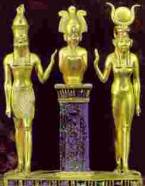
Holy Trinity from left to right: Osiris, Horus on the pillar and Isis.
Horus on the pillar represents the Sun on the Milky Way!
Below is the sky-chart of the summer solstice Great Celestial Conjunction (Galactic Alignment) of 1998. Notice how the Sun resides in between the horns of Taurus! Sirius, Orion, Taurus (Aldebaran) and the Pleiades are in line and form Osiris’s backbone! (The Pleiades are part of the constellation Taurus). The Pleiades show the way to the Sun on the Milky Way as we have demonstrated in our article ‘Stonehenge Summer Solstice Galactic Alignment’ and ‘2012 Freemasons Revelations’.
The importance of the crossing of the ecliptic and the Milky Way is expressed in several Egyptian texts such as in the Pyramid texts: ‘May you ferry over by means of the Great Bull’ and ‘The Bull of the Sky has bent down his horn that he may pass over thereby’. In the Coffin texts we find the expression: ‘O Horn, ferry across Him who is in his shrine’. I suggest that these texts hint at the precession of the Sun; it’s Horus who needs a ferry across the Milky Way river near the Gemini-Taurus nexus. Have a look at the next picture and see what the symbolism of Isis-Hathor represents.
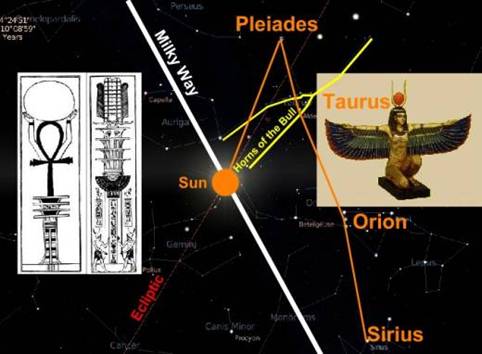
Hathor-Isis represents the crossing of the ecliptic and the
Milky Way near the Gemini-Taurus nexus.
There is another crossing of the Milky Way near the Sagittarius-Scorpio nexus where Horus requires a ferry to cross the Milky Way in the precession cycle. In the papyrus Khensumes the God Nun appears with outstretched arms and holds aloft the solar bark of the Heavens. The ship is made of two cosmic serpents (representing the ecliptic). In the Egyptian creation myths Nun is the female deity of the waters of chaos, the primeval waters.
Left: Nun holding the solar bark with the scarab beetle
Right: Scarab beetle 22nd Dynasty reign of Sheshong II
The boat Nun is lifting is occupied by 8 deities including the scarab deity Khepera. In the Egyptian mythology the scarab beetle (dung beetle) Khepera pushed the rolling Sun along the ecliptic with his hind legs, just like the scarab beetle rolls his dung ball around all day. From the dung ball of the scarab beetle the eggs of the beetle are hatched and therefore the dung ball can not only be associated with the Sun but with birth as well. Khepera was a minor solar deity in the Egyptian pantheon but he was associated with rebirth and resurrection, as such he may represent the rebirth of the Sun on the Galactic Cross. The fact that the scarab beetle pushes the dung ball (Sun) with his hind legs backwards suggests that he should be associated with precession. While the Sun moves through the zodiac in a tropical year in one direction, the precession of the equinox Sun along the ecliptic moves in the opposite direction! The scarab beetle pushing the Sun backwards along the ecliptic is expressing exactly this aspect of precession.
In the artefact of Sheshong we see the scarab beetle flanked by two cobras that emerge from the Shen (O| ring). The cobras suggest the ecliptic while the Shen suggest the crossings of the ecliptic and Milky Way. Tutankhamun’s cartouche contained a scarab beetle with the Sun inside the Shen glyph, which most likely expresses the idea of the Sun on the ecliptic-Milky Way crossing.
The scarab beetle, the scorpion and the crab all have hard shells and are very similar in appearance. The scarab beetle may also have been used as the sign of Scorpio. The scarab beetle rolling the Sun on the ecliptic may express the idea of the Sun precessing through the Galactic Equator near the Sagittarius-Scorpio nexus. Notice that there is a cross (Tau Cross) in the shell of the scarab beetle that was also depicted in Egyptian Hieroglyphs. The scarab beetle as a symbol expresses perfectly the crossing of the ecliptic and Milky Way near Scorpio. In the picture below the sky chart of the winter solstice of 1998 is depicted.
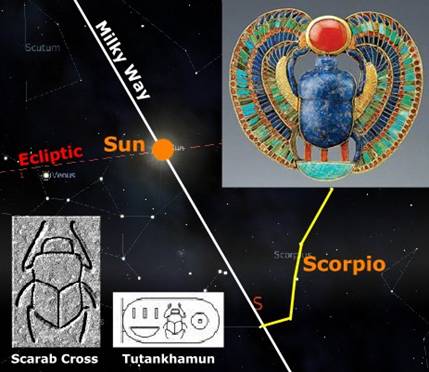
Scarab representing the crossing of the ecliptic and Milky Way
near Sagittarius-Scorpio nexus.
In the artefact depicted below, the two symbols that represent the two zodiac signs that correspond with the crossings of ecliptic and Milky Way are placed in barques and combined in one artefact. The barque expresses the fact that we are dealing with a crossing of the ecliptic and Milky Way since this is the place where the precessing Sun passes the great river in the sky, the Milky Way. Above we see the winged solar disk with two serpents representing the ecliptic.
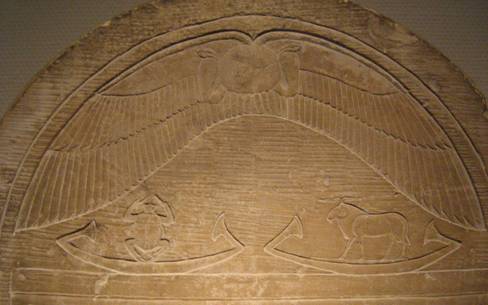
On the left the scarab beetle in a barque, on the right the bull with the horns in a barque.
The scarab beetle represents the Sagittarius-Scorpio nexsus while the horns of
the bull of course correspond with the Gemini-Taurus nexus.
Dutch national museum of antiquities, Leiden.
Circular Dendera Zodiac
In the roof temple of Hathor at Dendera we find the circular Dendera zodiac.
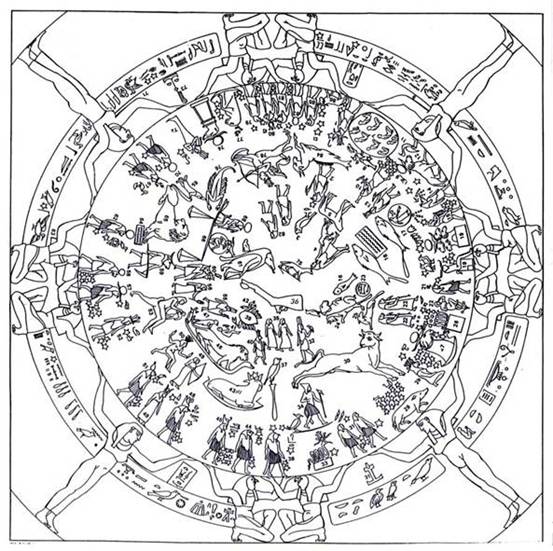
Dendera Zodiac, temple of Hathor
In the picture below we notice that Horus (1) is depicted in his barque on the Milky Way on the green cross. This cross represents the Galactic Cross since it runs through the signs Taurus, Aquarius, Scorpio and Leo. Horis needs his barque to cross the Milky Way (Great River in the sky) during a precession cycle when the Sun shifts through the Galactic Equator at Great Celestial Conjunction solstices and equinoxes as a result of precession.
Notice also that the bull with horns and solar disk (Taurus) is depicted multiple times (blue circles 2, 4, 6, 8, 9, 10). These bulls got the solar disk in between their horns and demonstrate that Isis-Hathor must have been regarded very important by the zodiac makers since it is referenced six times in the zodiac! The four bulls head on a pillar (9) might represent the four Great Celestial Conjunctions that occur during a Great Year. During a Great Year, the Sun aligns with the Milky Way near the Gemini-Taurus nexus on two equinoxes and two solstices, hence four conjunctions! Also the bull (2) with the horns and solar disk on the pillar next to Isis represents a conjunction of the Sun and Milky Way on the Gemini-Taurus nexus. Notice that Isis makes a four pointed cross with her flail and sceptre! Egyptian Pharaohs were buried in this gesture. The presence of all these bulls with the solar disks could mean that the Dendera Zodiac encodes Great Celestial Conjunctions.
|
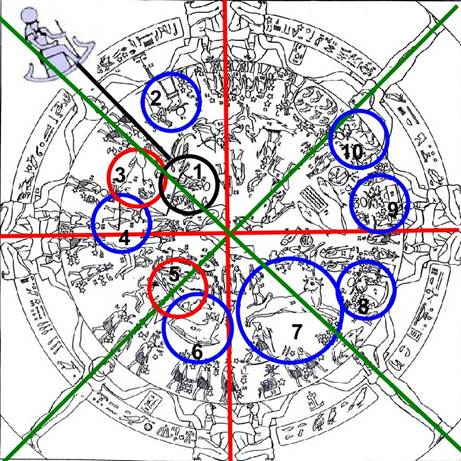
|

1 Horus
2 Cow with solar disk
3 Leo with tail up
4 Cow with solar disk
5 Leo with tail down
6 Cow with solar disk
7 Taurus
8 Cow with solar disk
9 Cow with solar disk
10 Cow with solar disk

|
Dendera Zodiac, red circles contain the signs of Leo. The blue circles contain the signs of Taurus. In the black circle Horus in depicted in his barque on the Milky Way and the Galactic Cross (green cross)
In the picture below all of the signs of the zodiac are encircled and numbered. Notice that the signs are not evenly distributed. There are also two four pointed crosses in the zodiac. The green cross represents the Galactic Cross since it runs exactly through the signs Aquarius, Scorpio, Leo and Taurus. The second cross red cross runs next to the signs Capricorn, Libra, Cancer and Aries and I suggest it represents the Earth Cross.
The Earth Cross (red cross) is held by Horus (falcon headed deity) who’s depicted in twofold in the outer rim of the zodiac. Horus is holding the Earth Cross because he represents the Sun that moves along the zodiac during the precession cycle. The Galactic Cross (green cross) is held by the female deity Isis. Isis is associated with the fixated Galactic Cross since she corresponds with the Gemini-Taurus nexus where the ecliptic and the Milky Way intersect.
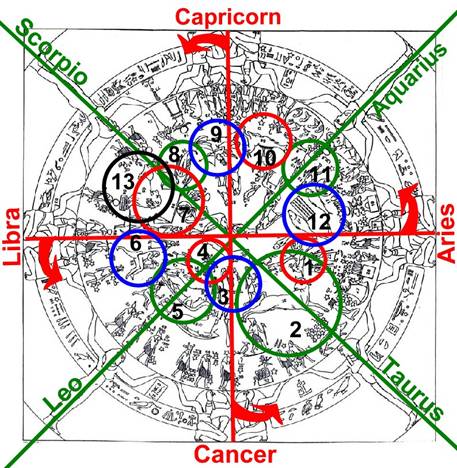 |
1 Aries
2 Taurus
3 Gemini
4 Cancer
5 Leo
6 Virgo
7 Libra
8 Scorpio
9 Sagittarius
10 Capricorn
11 Aquarius
12 Pisces
13 Lion
|
Dendera Zodiac contains an 8 pointed cross.
The green cross represents the Galactic Cross.
The red cross represents the Earth Cross, the red arrows
correspond with the counter clockwise direction of precession
Apparently the designers of the zodiac wanted to preserve the symmetry of the 8 pointed cross otherwise the Earth Cross would have been drawn straight through the signs Capricorn, Libra, Cancer and Aries as was done with the Galactic Cross. However for the Earth Cross the signs are depicted next to the cross. |
|
|
|
|
There is another very important reason why this was done. If we look at the sign Cancer (4) we notice that it is not placed on the Earth Cross (red cross) where it should have been if the signs were evenly distributed, instead Gemini (3) takes its place. Cancer (4) is placed to the left and pushed upwards on the Galactic Cross along with Leo (5)! This odd placement of Cancer could suggest the conjunction of the Earth Cross and Galactic Cross!
The conjunction of both crosses is also suggested by depicting Leo twice in the zodiac. Leo is depicted once near the Earth Cross (13) and once where he really belongs on the Galactic Cross (5) (see picture above)
In addition the tail of the lion near the Earth Cross (13) is turned up over his back while the lion is looking at its own tail. The tail of the lion near the Galactic Cross (5) has his tail turned down. The tail has swayed in counter clockwise direction, the direction of precession in the Dendera Zodiac (notice the red arrows on the Earth Cross). As a result of the counter clockwise rotation of the Earth Cross, it becomes conjunct with the Galactic Cross where the second lion is depicted! In addition the Lion on the Galactic Cross (5) is now depicted on a barque as if he’s travelled!
Left : Lion (13) corresponding with the Earth Cross
Right: Lion (5) corresponding with the Galactic Cross,
this lion is placed inside a barque!
Dendera Zodiac and Great Celestial Conjunctions
R.A. Schwaller de Lubicz has pointed out that there are two hieroglyphs (1, 8) used on the exterior of the zodiac disk that represents the cardinal directions East and West (see picture below). In other words the axis (blue line) drawn through these glyphs represents an equinoctial axis and Schwaller de Lubicz believed that this line encoded the start date of the cult of the sacred bull Apsis and the inauguration of the new Pharonic calendar around 4240 BC. This time coincidentally happens to be close to the previous Great Celestial Conjunction!
Let’s have a careful look at the equinoctial line (blue line); it passes in between Gemini (5) -Taurus (6) and Sagittarius (4) -Scorpio (3). In other words the equinoctial axis also represents the Galactic Equator. Both the Galactic Equator and the equinoctial axis align! Gemini occurs twice (5, 7), once on the Galactic Equator (5) and once on the rim (7) near the East glyph (8). At the other end of the Galactic Equator we find Sagittarius (4) and Scorpio (3). Near the West glyph on the Galactic Equator we find Isis and the cow with the solar disk in between the horns placed on a pillar (2)! This glyph suggests the Sun on the Milky Way near the Gemini-Taurus nexus; it’s the symbolism behind Isis-Hathor that we decoded above!
We therefore conclude that Schwallar de Lubicz equinoctial axis is in fact encoding the Great Celestial Conjunction about 6480 years ago when the vernal equinox aligned with the Galactic Plane near the Taurus-Gemini nexus. In other words the equinoctial line through the hieroglyphs of East and West (blue line) in the Dendera zodiac encodes the Great Celestial Conjunction around 4480 BC. This is within a 240 year range of Schwaller de Lubicz estimated year. Since the year 4480 BC for the previous Great Celestial Conjunction is an estimation that is based on a Platonic Year (25920 years) that various within time, it’s safe to suggest that the previous Great Celestial Conjunction was indeed targeted by the Dendera zodiac.
|
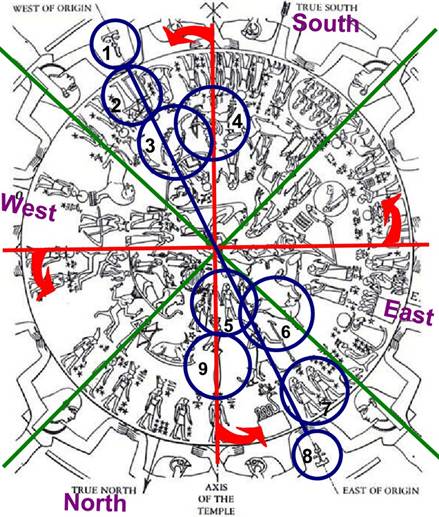
|

1 West glyph
2 Isis-Taurus
3 Scorpio
4 Sagittarius
5 Gemini
6 Taurus
7 Gemini
8 East glyph
9 Horus on pillar

|
Dendara Zodiac Swaller de Lubicz.
On the outer rim the hieroglyphs of the cardinal directions east and west appear.
But let’s also point out an inconsistency as well! The blue line in the picture above denotes the equinox axis that aligns with the Milky Way at the Gemini-Taurus nexus in the constellation Gemini. However at the opposite side of the Galactic Equator at the Sagittarius-Scorpio nexus, the equinox axis runs through Scorpio (3) instead of Sagittarius (4) which is incorrect! Fortunately there is a very specific reason for this and we can pardon the zodiac makers; Sagittarius had to be used for another Galactic Equator axis in de zodiac as well and it can’t be in two places at the same time. If we take a look at the axis that reads ‘Axis of the Temple’ (vertical red line, picture above) we notice that this line runs through Gemini (5) and Sagittarius (4), this is the correct axis for the Galactic Equator! In addition Horus (Sun) appears on the pillar (Milky Way) (9). Horus is actually represented here as the falcon (Horus is the falcon headed deity) on a papyrus stem, but the symbology is identical, solar god on the pillar, the Sun on the Galactic Equator.
Could it be that there is another Great Celestial Conjunction encoded in the Dendera zodiac?
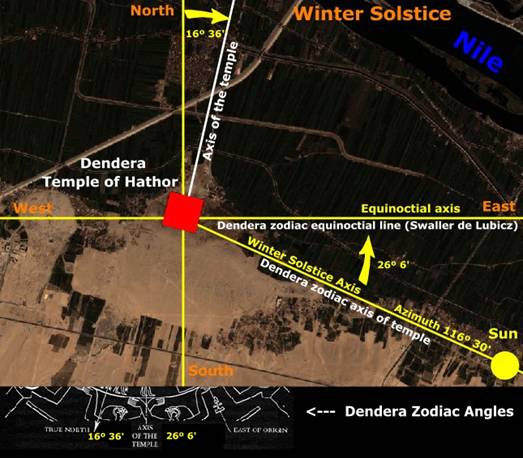
Dendera, Winter Solstice Sunrise
In the picture above the winter solstice at Dendera is depicted. Notice that the azimuth of the winter solstice sunrise at Dendera is 116 º 30’. The angle between Swaller de Lubicz equinoctial axis and the Axis of the Temple in the zodiac is exactly 26 º 6’ (See bottom of the picture above).
But this angle also happens to be the exact angle between the vernal equinox axis and the winter solstice axis!
The accuracy is stunningly precise! But what does it mean?
If we rotate the red line of the Axis of the Temple that we just identified as the Galactic Equator over an angle of 26 º 6’ in the direction of precession, that is to say in a counter clockwise direction, the axis will align with Schwaller de Lubicz equinoctial line. We therefore suggest that the red line of the Axis of the Temple also corresponds with the winter solstice axis (see picture above). But if this is true we have a winter solstice axis aligned with the Galactic Equator, in other words we’ve found another Great Celestial Conjunction!
This Great Celestial Conjunction occurred half a precession cycle ago around 10.500 BC when the Sun aligned with the Galactic Equator near the Gemini-Taurus nexus (Isis-Hathor association) on the winter solstice. This time corresponds with the Egyptian first time or Zep Tepi and the time of the Great Flood. Not only the Sumerians and Babylonians paid much attention to the Great Celestial Conjunction of half a precession cycle ago (Great Flood), but the Egyptians as well!
Rectangular Dendera Zodiac
In the Hypostyle Hall at Dendera we find the rectangular zodiac. The zodiac is flanked by two deities that are both adorned with 8 pointed crosses (rose like). The 8 pointed cross exists of a 4 pointed cross with large petals and one with small petals that are superimposed. The crosses appear from head to toe and four additional crosses are depicted near the head that may represent the four Great Celestial Conjunctions in a Great Year.
Rectangular zodiac Dendera
The rectangular Dendera zodiac expresses the importance of the ecliptic-Milky crossings in various ways and it seems to be the most important message of this zodiac. All deities in the bottom bar are placed inside barques beneath the zodiac signs; they suggest they are travelling along the ecliptic. The barque is required to cross the great river in the sky, the Milky Way when the gods travel along the ecliptic in a precession cycle. Near the female’s head with the 8 pointed crosses, the winged disk of Ra is depicted. Ra as the solar god travels along the ecliptic during a precession cycle.
Top: the four signs associated with the Galactic Equator and deity in circle
Bottom left: Winged disk of Ra as the sun travelling along the ecliptic
Bottom centre: Notice the 8 pointed crosses from head to toe on the deity
Bottom right: The bull Taurus with the solar disk in the nape of his neck
At the exact place where the ecliptic crosses the Milky Way at the Sagittarius-Scorpio nexus a deity is placed seated inside a circle in a boat! I suggest that he’s inside a womb since this place is the birthplace of the Sun on the Galactic Cross. He’s the only deity that is seated; all other deities are standing erect. The zodiac signs that are associated with the ecliptic-Milky Way crossings are placed in the sequence Taurus, Sagittarius, Gemini, Scorpio and not in the natural order they occur in the zodiac. Grouping them together in this way expresses the fact that these signs are important and belong together. They belong to the Galactic Equator! In addition in the zodiac Taurus the bull is depicted with the solar disk on his back (Isis-Hathor association, sun on the Milky Way near Gemini-Taurus).
Leg of the Bull
In the centre of the circular Dendera zodiac as well as in the rectangular Dendera zodiac (see picture above) there is a theme depicted that is recurring in several Egyptian temples. It has to do with the leg or thigh constellation of the bull (Taurus). While some researchers such as Robert Bauval and Andrew Collins have identified the ‘Leg of the Bull’ with Ursa Major (Big Dipper), others like Wayne Herschel have identified the ‘Leg of the Bull’ constellation with the Pleiades. The Pleiades in shape resemble a leg and in the Book of the Dead a text alludes to Sokar (tripartite deity Ptah-Sokar-Osiris) slaying of the Bull and chopping off of his leg. The severed leg of Taurus was transferred to another place in the sky, a so called mooring post in the sky that presumably corresponds with the Pleiades.
I fully endorse Herschel’s research, however I do not share his conclusions that the Pleiades in the star maps that he’s discovered around the world point to a star. He believes that the Egyptians did not worship Ra our own Sun, but instead worshiped another Sun like star that belonged to another solar system. This solar system was the home of extraterrestrials who in ancient times visited Earth according to Herschel. I suggest that Herschel’s mystery star in fact is the Sun on the Galactic Equator near the Gemini-Taurus nexus. The Pleiades are simply a pointer to the Sun on the Milky Way. Earlier I decoded the role of the Pleiades as a pointer to the summer solstice Sun on the Milky Way in my Stonehenge and the Freemasons Revelations article.
The Leg of the Bull theme is presented in the centre of the circular zodiac and expresses its importance. In the temple of Hathor at Dendera a text occurs that refers to the ‘Leg of the Bull’.
“The living god Thoth – nourished by the sublime goddess in the temple – the sovereign of the country – stretches the rope in joy (align with it) – With his glance .. - ..towards the ‘ak’ of the bull’s thigh constellation.. – he establishes the temple house of the mistress of Dendera, as it took place there before”
(Wayne Herschel, The Hidden Records, pg 141)
I believe that this text is referring to the Galactic Alignment (align with it) that have occurred in ancient past (took place there before) and that the Pleiades (Ak of the bull’s thigh constellation) is the pointer to this alignment of the Sun on the Milky Way near the Gemini-Taurus nexus (establishes the temple house of the mistress of Dendera).
|
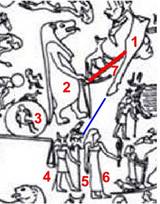
|
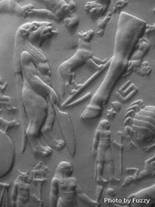
|
1 Leg of the Bull
2 Hippo associated with birth
3 Deity in circle (womb)
4 Falcon headed deity Horus
5 Cow with falcon on his back
6 Isis
7 Umbilical cord
|
Leg of the Bull, Dendera zodiac
In the picture above the Leg of the Bull (1) of Dendera is depicted. Notice that this leg is pointing to the cow with the falcon on top (5). The falcon (Horus) on the back of the cow represents the Sun on the Milky Way near the Gemini-Taurus nexus. To the left the falcon headed Horus (4) is depicted and he’s accompanied by Isis to the right (6). Notice the little deity inside the circle (3). It may represent the womb that contains the foetus Horus, who as son of Isis is to be reborn as the Sun on the Galactic Cross during a Great Celestial Conjunction. Remember that we saw a similar deity inside a circle in the rectangular Dendera zodiac exactly at the crossing place of ecliptic and Milky Way in Gemini, the birthplace of the Sun!
The hippopotamus deity (2) is Taweret or Thoeris. In the Old Kingdom she was seen as the protector of childbirth and was depicted pregnant. Her celestial counterpart is the northern constellation Draco. Taweret was often depicted with a crocodile on her back. Draco resides next to Cygnus, the constellation of the swan also known as the Northern Cross. At Cygnus the Dark Rift of the Milky Way starts and runs down all the way to the Sagittarius-Scorpio nexus. The crocodile on the back of Taweret therefore represents the Milky Way and the mouth of the crocodile represents the Dark Rift. Taweret was also associated with Hathor and was also depicted with the solar disk and horns.
Left: Hippo Taweret with the crocodile
Right: Taweret with the Ankh and solar disk in between the horns on a pillar
Taweret can therefore both be associated with both the Sagittarius-Scorpio nexus (crocodile, Dark Rift association) and the Gemini-Taurus nexus (Isis-Hathor, sun disk and horns association). Appearing in the centre of the zodiac she represents the midwife who will help with the rebirth of the Sun on the ecliptic Milky Way crossings. One birthplace is represented by Isis-Hathor; it’s the place where the Sun resides in between the horns of Taurus, the other is the mouth of the crocodile on the back of Taweret, it’s the Dark Rift. Notice how Taweret is connected through a kind of umbilical cord to the Leg of the Bull (red line).
The Leg of the Bull is also depicted on the ceiling in the tomb of Seti I and in murals in the tomb of Senmut. In the tomb of Senmut we see Sokar pointing his spear at the Leg of the Bull (not to be mistaken for Taurus). The Leg of the Bull is the Pleiades in the constellation Taurus. Isis with the solar disk in between her horns appears beside the Leg of the Bull. The Leg of the Bull is pointing to a particular place, a red dot (star) on a pillar erected from the Earth. Next to the pillar (obelisk?) we find the hippo deity Taweret and a figure pointing upwards to the skies.
Tomb of Senmut, Deir el Bahri Egypt. Upper right corner, the Leg of the Bull theme.
Sokar points with his spear towards the Leg of the Bull.
This is how I think the Leg of the Bull theme should be interpreted (see picture below); Sokar (Ptah-Sokar-Osiris) with his spear represents Orion that is pointing the way to the Pleiades in Taurus. As the falcon headed deity, Sokar is often also associated with Horus. The Pleiades are a pointer to the crossing of the ecliptic and the Milky Way where the sun resides during Galactic Alignments on solstices and equinoxes. The obelisk like pillar actually represents the Milky Way. The Pleiades occur above the back of Taurus. In the Leg of the Bull theme in the tomb of Senmut however it is depicted as the tail of the bull. The tail functions as the pointer and thus points the way. So the Leg of the Bull theme does not represent the actual representation of the star configurations in the sky but should be interpreted symbolically. Notice that the bull as Taurus is shaped in the form of the leg itself! Taweret is present to assist with the birth of the Sun.
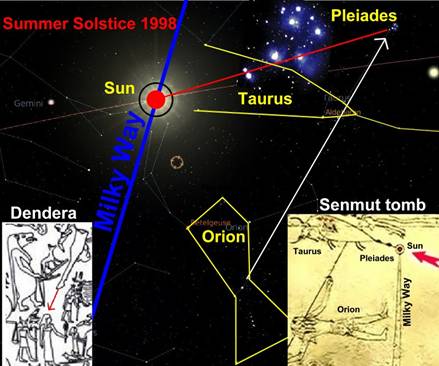
Leg of the Bull, Dendera and Senmut tomb. Notice that while the horns of Taurus correspond with the mural of Senmut, the Milky Way resides to the left and not to the right as is depicted in the mural.
The reason why the mural of the Senmut tomb does not correspond with the situation in the sky is that the graphical representation was meant to symbolically depict the Galactic Alignment. The Sun and Milky Way actually should have appeared left of Orion, but it would have destroyed the simplicity and symbolism of the Leg of the Bull theme in the mural.
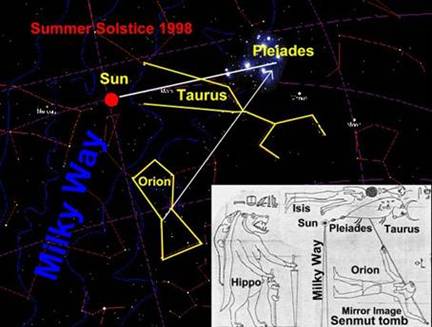
Mirror image of the Leg of the Bull, Senmut tomb
Greek influence
There’s one inconsistency concerning the circular Dendera zodiac that I would like to explain. The zodiac makers on one hand used the heliacal rising of stars to denote the Galactic Cross and Earth Cross, while on the other hand they used the exact constellations to denote the Galactic Equator. Scholars agree that the temple of Hathor was built in the Ptolemaic period (304-30 BC) but the majority of the Dendera complex must be dated back to ancient times of the Old and Middle Dynasties. The Greco-Roman influence in the construction of the temple of Hathor explains why different references to the Galactic Cross have been blended and used in the Dendera zodiac. Referencing the Galactic cross by means of the four cherubim is a custom that can be traced back to ancient Sumer and Babylon, while the Greek and Romans used the exact Sun-constellation conjunctions to denote celestial events (Also see the paragraph about the Greek Cross below). Ancient astronomical understanding may have been blended with Roman/Greek astronomical knowledge in the Dendera zodiac making it hard and confusing to understand. It explains why many scholars have proposed different theories about the enigmatic zodiac. |
|
|
 Primer
Primer
 Anterior
2 a 5 de 50
Següent
Anterior
2 a 5 de 50
Següent Darrer
Darrer
|
|
| |
|
|
©2024 - Gabitos - Tots els drets reservats | |
|
|

